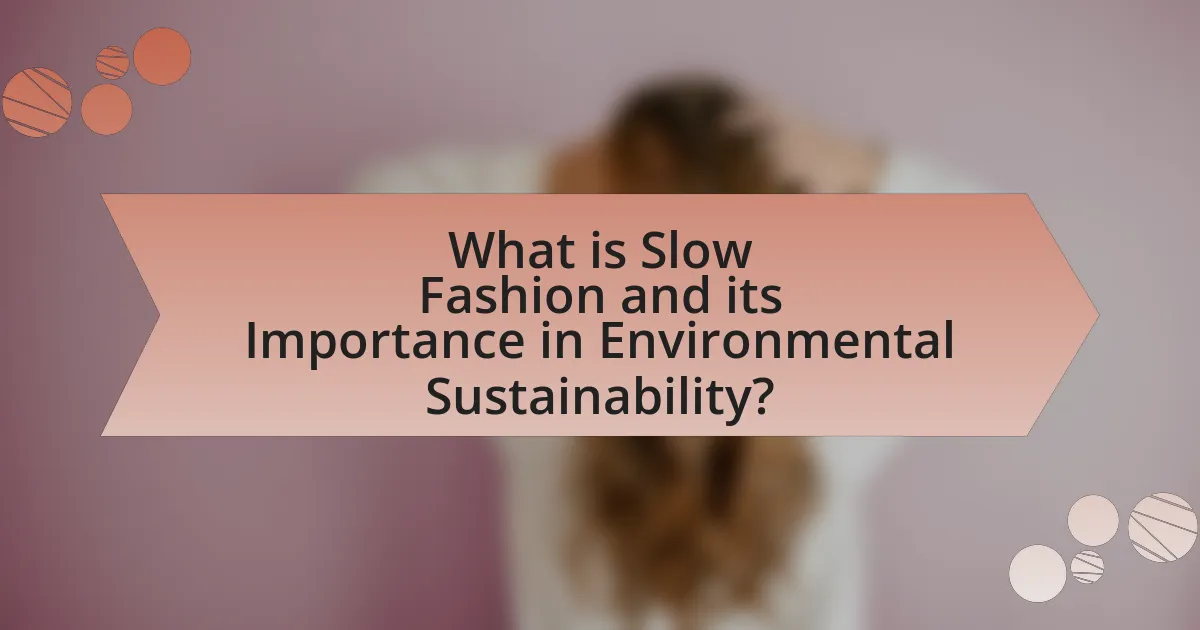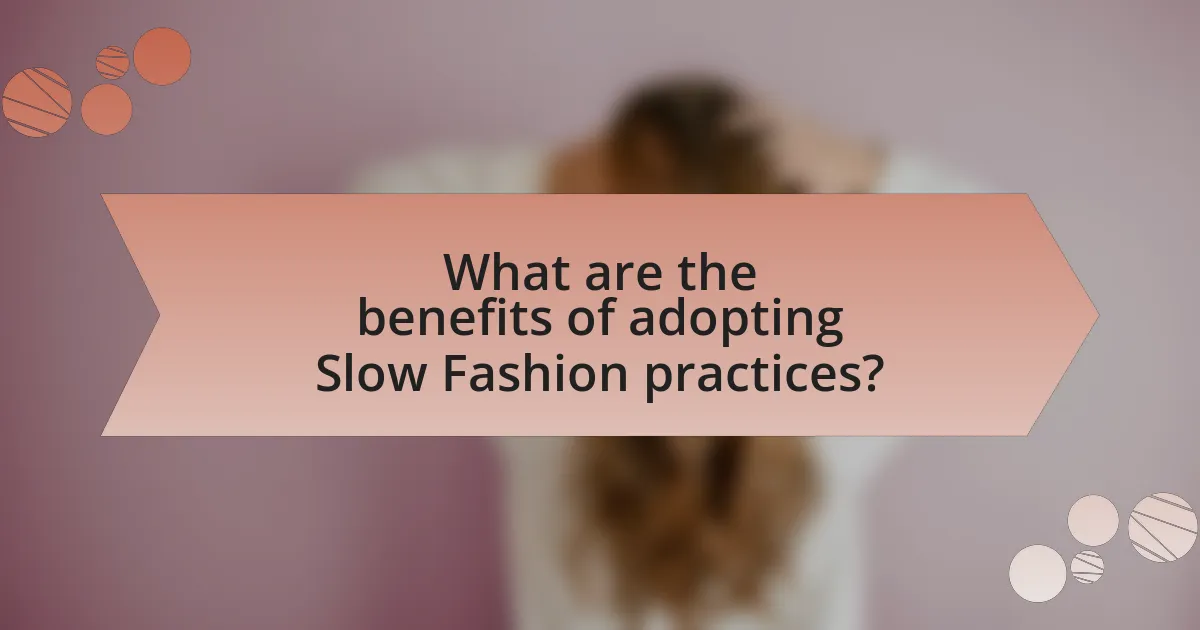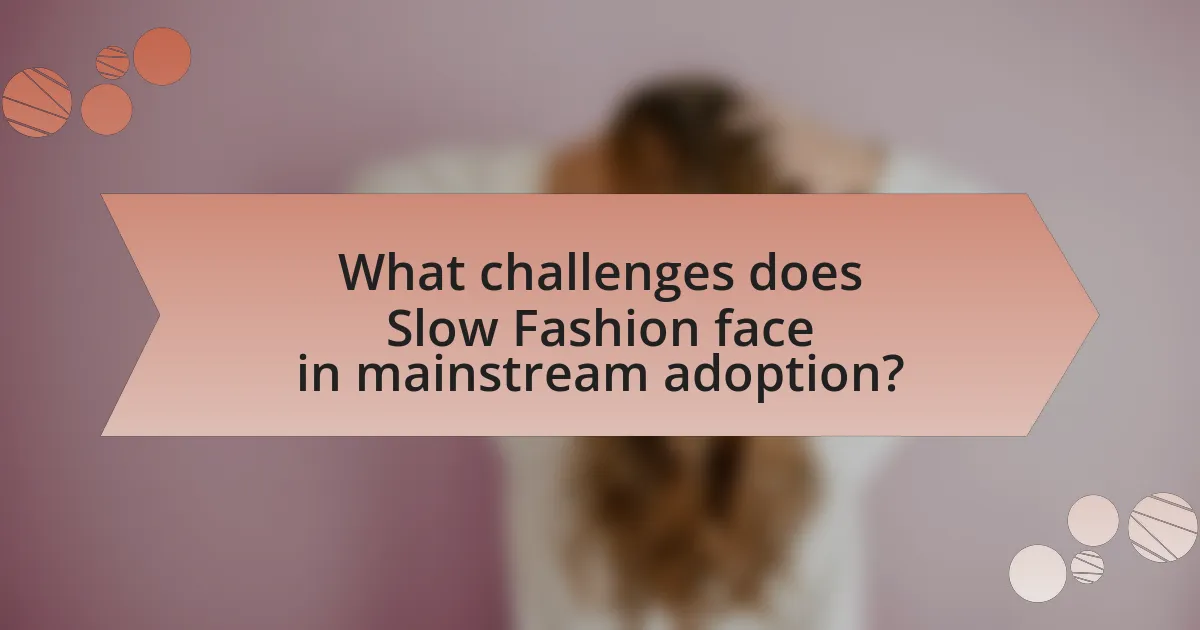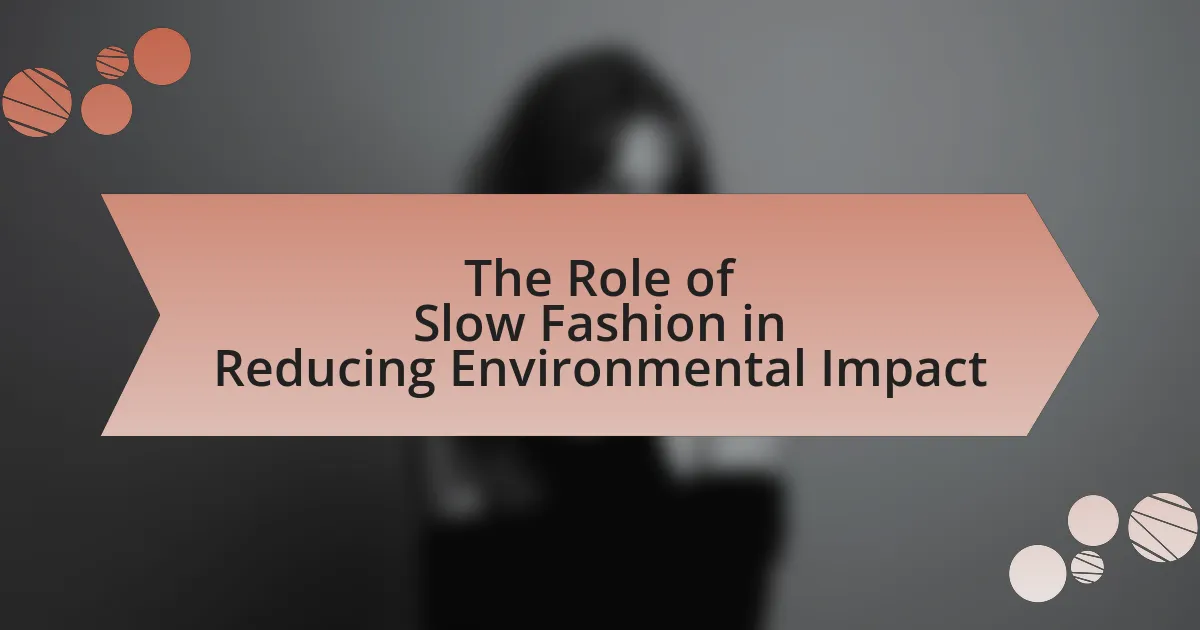Slow fashion is an approach to clothing production and consumption that prioritizes quality, sustainability, and ethical practices, contrasting sharply with the fast fashion model that emphasizes rapid production and low costs. This article explores the significance of slow fashion in promoting environmental sustainability by reducing waste, conserving resources, and encouraging the use of eco-friendly materials. It highlights the detrimental environmental impacts of fast fashion, including high levels of waste and pollution, and discusses the key characteristics of slow fashion, such as ethical sourcing and timeless design. Additionally, the article examines the economic and health benefits of adopting slow fashion practices, the challenges faced in mainstream adoption, and practical steps consumers can take to embrace a more sustainable wardrobe.

What is Slow Fashion and its Importance in Environmental Sustainability?
Slow fashion is an approach to clothing production and consumption that emphasizes quality, sustainability, and ethical practices over fast, mass-produced fashion. This movement is important for environmental sustainability because it reduces waste, conserves resources, and promotes the use of eco-friendly materials. For instance, the fashion industry is responsible for approximately 10% of global carbon emissions and significant water pollution; slow fashion aims to mitigate these impacts by encouraging consumers to buy less and choose durable, timeless pieces. By prioritizing sustainable practices, slow fashion contributes to a circular economy, where products are designed for longevity and recyclability, ultimately leading to a decrease in environmental degradation.
How does Slow Fashion differ from Fast Fashion?
Slow Fashion emphasizes sustainability and ethical production, while Fast Fashion prioritizes rapid production and low costs. Slow Fashion focuses on high-quality materials, craftsmanship, and timeless designs, resulting in longer-lasting garments. In contrast, Fast Fashion produces inexpensive, trend-driven clothing that is often discarded after a few wears, contributing to significant waste. According to the Ellen MacArthur Foundation, the Fast Fashion industry is responsible for 92 million tons of textile waste annually, highlighting the environmental impact of its business model.
What are the key characteristics of Slow Fashion?
Slow Fashion is characterized by sustainability, quality craftsmanship, ethical production, and timeless design. Sustainability focuses on minimizing environmental impact through eco-friendly materials and processes. Quality craftsmanship emphasizes durable, well-made garments that outlast fast fashion items, reducing waste. Ethical production ensures fair labor practices and transparency in the supply chain, promoting social responsibility. Timeless design encourages consumers to invest in versatile pieces that remain stylish over time, countering the cycle of disposable fashion. These characteristics collectively contribute to a more responsible and environmentally conscious approach to clothing consumption.
Why is Fast Fashion considered harmful to the environment?
Fast fashion is considered harmful to the environment primarily due to its high levels of waste, pollution, and resource consumption. The fast fashion industry produces approximately 92 million tons of textile waste annually, much of which ends up in landfills, where it can take decades to decompose. Additionally, the production processes involved in fast fashion contribute significantly to water pollution, with an estimated 20% of global wastewater coming from textile dyeing and treatment. Furthermore, fast fashion relies on the rapid extraction of natural resources, leading to deforestation and depletion of water supplies. These factors collectively highlight the detrimental environmental impact of fast fashion, underscoring the need for more sustainable practices in the fashion industry.
What are the environmental impacts of the fashion industry?
The environmental impacts of the fashion industry are significant, primarily involving pollution, resource depletion, and waste generation. The industry is responsible for approximately 10% of global carbon emissions, largely due to energy-intensive production processes and transportation. Additionally, it consumes vast amounts of water; for instance, producing a single cotton t-shirt requires about 2,700 liters of water, which is enough for one person to drink for two and a half years. Furthermore, the fashion industry contributes to water pollution, with textile dyeing processes releasing toxic chemicals into waterways, affecting aquatic ecosystems and human health. Lastly, the industry generates substantial waste, with an estimated 92 million tons of textile waste produced annually, much of which ends up in landfills. These factors collectively highlight the urgent need for sustainable practices within the fashion sector.
How does textile production contribute to pollution?
Textile production contributes to pollution primarily through the release of harmful chemicals, excessive water usage, and waste generation. The dyeing and finishing processes often involve toxic substances, such as heavy metals and synthetic dyes, which can contaminate water sources. According to the World Bank, textile dyeing is responsible for 20% of global water pollution. Additionally, the production process consumes vast amounts of water; for instance, producing one kilogram of cotton can require up to 20,000 liters of water. Furthermore, the industry generates significant solid waste, with the Ellen MacArthur Foundation estimating that 92 million tons of textile waste are created annually, much of which ends up in landfills.
What role does waste play in the environmental footprint of fashion?
Waste significantly contributes to the environmental footprint of fashion by generating pollution and depleting resources. The fashion industry produces approximately 92 million tons of textile waste annually, with a large portion ending up in landfills, where it can take decades to decompose and release harmful greenhouse gases. Additionally, the production of clothing often involves the use of water, chemicals, and energy, which are wasted when garments are discarded prematurely. This cycle of overproduction and waste not only exacerbates environmental degradation but also highlights the need for sustainable practices, such as slow fashion, which emphasizes quality over quantity and aims to reduce waste through mindful consumption.
How does Slow Fashion contribute to reducing environmental impact?
Slow Fashion contributes to reducing environmental impact by promoting sustainable production practices and encouraging mindful consumption. This approach minimizes waste through the use of high-quality materials that last longer, reducing the frequency of purchases and the overall demand for fast fashion, which is responsible for significant pollution and resource depletion. For instance, the fashion industry accounts for approximately 10% of global carbon emissions, and Slow Fashion aims to mitigate this by emphasizing local production, ethical labor practices, and reduced transportation emissions. By fostering a culture of repair, reuse, and recycling, Slow Fashion directly addresses the environmental challenges posed by conventional fashion practices.
What sustainable practices are promoted by Slow Fashion?
Slow Fashion promotes sustainable practices such as ethical sourcing, reduced waste, and the use of eco-friendly materials. Ethical sourcing involves selecting materials and labor that prioritize fair wages and safe working conditions, which supports local economies and reduces exploitation. Reduced waste is achieved through practices like upcycling and designing for longevity, encouraging consumers to buy less and invest in quality pieces that last longer. The use of eco-friendly materials, such as organic cotton or recycled fabrics, minimizes environmental harm by reducing chemical usage and resource depletion. These practices collectively contribute to a more sustainable fashion industry, aligning with the principles of environmental stewardship and social responsibility.
How does Slow Fashion encourage mindful consumption?
Slow Fashion encourages mindful consumption by promoting the idea of quality over quantity, urging consumers to invest in durable, ethically produced garments rather than fast, disposable fashion. This approach fosters a deeper connection between consumers and their clothing, as it emphasizes the importance of understanding the environmental and social impacts of their purchases. Research indicates that Slow Fashion can reduce waste and resource consumption, as consumers are encouraged to buy less frequently and choose items that are sustainable and timeless, thereby minimizing their overall environmental footprint.

What are the benefits of adopting Slow Fashion practices?
Adopting Slow Fashion practices offers significant benefits, primarily in reducing environmental impact. Slow Fashion emphasizes quality over quantity, leading to less waste and lower resource consumption. For instance, the production of one cotton t-shirt requires approximately 2,700 liters of water; by choosing sustainable materials and ethical production methods, Slow Fashion can drastically reduce water usage and pollution associated with fast fashion. Additionally, Slow Fashion promotes longer-lasting garments, which decreases the frequency of purchases and ultimately minimizes textile waste in landfills. According to a study by the Ellen MacArthur Foundation, if the fashion industry shifted towards a circular economy, it could reduce its greenhouse gas emissions by 44% by 2030. Thus, adopting Slow Fashion practices not only benefits the environment but also supports sustainable economic models.
How does Slow Fashion support local economies?
Slow Fashion supports local economies by prioritizing local production and craftsmanship, which fosters job creation and sustains small businesses. This approach encourages consumers to purchase from local artisans and manufacturers, thereby keeping financial resources within the community. According to a report by the Ethical Fashion Forum, local production can lead to a 30% increase in local employment opportunities, as it reduces reliance on mass production and global supply chains. Additionally, Slow Fashion promotes sustainable practices that often align with local cultural heritage, further enhancing community identity and economic resilience.
What are the economic advantages of supporting local artisans?
Supporting local artisans provides significant economic advantages, including job creation and the retention of wealth within local communities. By purchasing handmade goods, consumers directly contribute to the livelihoods of artisans, which fosters economic stability. According to a report by the American Craft Council, local artisans generate approximately 2.5 million jobs in the U.S. alone, emphasizing their role in the economy. Additionally, money spent on local artisans tends to circulate within the community, leading to a multiplier effect that boosts local businesses and services. This localized economic activity not only strengthens community ties but also promotes sustainable practices, aligning with the principles of slow fashion that prioritize quality and environmental responsibility.
How does Slow Fashion create job opportunities in sustainable sectors?
Slow Fashion creates job opportunities in sustainable sectors by promoting ethical production practices and supporting local artisans. This approach emphasizes quality over quantity, leading to increased demand for skilled labor in areas such as textile production, garment construction, and sustainable sourcing. For instance, a report by the Global Fashion Agenda highlights that the shift towards sustainable fashion could generate 1.5 million new jobs by 2030, particularly in regions where traditional craftsmanship is valued. By investing in local communities and sustainable materials, Slow Fashion not only fosters economic growth but also enhances environmental stewardship, thereby reinforcing the interconnectedness of job creation and sustainability.
What health benefits are associated with Slow Fashion?
Slow Fashion promotes health benefits by encouraging the use of natural, non-toxic materials in clothing, which reduces exposure to harmful chemicals often found in fast fashion garments. This approach minimizes skin irritations and allergic reactions associated with synthetic fabrics treated with hazardous substances. Additionally, Slow Fashion emphasizes sustainable practices that contribute to mental well-being by fostering a connection to the environment and promoting mindfulness in consumption, which can reduce stress and anxiety. Studies indicate that sustainable fashion practices can lead to improved overall health outcomes by supporting a healthier ecosystem, which in turn benefits human health.
How do natural materials in Slow Fashion impact consumer health?
Natural materials in Slow Fashion positively impact consumer health by reducing exposure to harmful chemicals commonly found in synthetic textiles. For instance, organic cotton and linen are grown without pesticides and synthetic fertilizers, which lowers the risk of skin irritations and allergic reactions in consumers. Additionally, natural fibers are often more breathable and biodegradable, contributing to a healthier environment and reducing the accumulation of microplastics that can enter the human body through various channels. Studies have shown that clothing made from natural materials can enhance comfort and overall well-being, as they are less likely to cause skin issues compared to garments made from synthetic fibers.
What are the psychological benefits of choosing Slow Fashion?
Choosing Slow Fashion provides psychological benefits such as increased satisfaction and reduced anxiety. Engaging in Slow Fashion allows individuals to make mindful purchasing decisions, fostering a sense of control and empowerment over their consumption habits. This intentionality can lead to a deeper appreciation for clothing, enhancing emotional well-being. Research indicates that consumers who prioritize sustainable practices often report higher levels of happiness and fulfillment, as they align their values with their purchasing choices. Additionally, the community aspect of Slow Fashion, which often includes local artisans and ethical brands, can create a sense of belonging and social connection, further contributing to positive mental health outcomes.

What challenges does Slow Fashion face in mainstream adoption?
Slow Fashion faces significant challenges in mainstream adoption primarily due to consumer behavior and market dynamics. Many consumers prioritize fast fashion due to its affordability and convenience, which creates a barrier for Slow Fashion brands that often have higher price points and longer production times. Additionally, the lack of awareness about the environmental benefits of Slow Fashion contributes to its limited appeal; a 2021 survey by McKinsey & Company found that only 30% of consumers are aware of the negative impacts of fast fashion. Furthermore, the existing retail infrastructure heavily favors fast fashion, making it difficult for Slow Fashion brands to compete effectively. These factors collectively hinder the widespread acceptance and growth of Slow Fashion in the mainstream market.
What are the barriers to consumer acceptance of Slow Fashion?
The barriers to consumer acceptance of Slow Fashion include higher costs, limited availability, and a lack of awareness. Higher costs deter consumers who are accustomed to fast fashion prices, as Slow Fashion often involves sustainable materials and ethical labor practices that increase production expenses. Limited availability restricts access to Slow Fashion brands, making it difficult for consumers to find products that align with their values. Additionally, a lack of awareness about the environmental benefits of Slow Fashion contributes to consumer hesitation, as many individuals remain uninformed about the negative impacts of fast fashion on the environment. According to a study published in the Journal of Fashion Marketing and Management, 60% of consumers prioritize price over sustainability, highlighting the significant challenge Slow Fashion faces in gaining widespread acceptance.
How does price sensitivity affect consumer choices?
Price sensitivity significantly influences consumer choices by determining how much consumers are willing to pay for products. When consumers exhibit high price sensitivity, they are more likely to seek alternatives or delay purchases in response to price increases. For instance, a study by the Journal of Consumer Research found that consumers are more likely to switch brands or opt for lower-priced items when faced with higher prices, indicating that price sensitivity directly impacts purchasing behavior. This behavior is particularly relevant in the context of slow fashion, where consumers may prioritize cost over sustainability, potentially undermining the environmental benefits of choosing ethically produced clothing.
What role does marketing play in the perception of Slow Fashion?
Marketing plays a crucial role in shaping the perception of Slow Fashion by emphasizing its values of sustainability, ethical production, and quality over quantity. Through targeted campaigns, brands communicate the environmental benefits of Slow Fashion, such as reduced waste and lower carbon footprints, which resonate with environmentally conscious consumers. For instance, studies show that 66% of consumers are willing to pay more for sustainable brands, indicating that effective marketing can significantly influence purchasing decisions. By highlighting stories of artisans, transparent supply chains, and the longevity of products, marketing fosters a deeper connection between consumers and the Slow Fashion movement, ultimately enhancing its appeal and acceptance in the marketplace.
How can the fashion industry overcome these challenges?
The fashion industry can overcome challenges by adopting slow fashion principles that prioritize sustainability and ethical practices. Implementing these principles involves reducing waste through careful production planning, utilizing eco-friendly materials, and promoting transparency in supply chains. For instance, a study by the Ellen MacArthur Foundation highlights that transitioning to a circular economy in fashion could reduce greenhouse gas emissions by 44% by 2030. Additionally, brands that focus on quality over quantity can foster consumer loyalty and reduce overconsumption, as evidenced by the growing market for second-hand clothing, which is projected to reach $64 billion by 2024. By embracing these strategies, the fashion industry can effectively address its environmental impact while meeting consumer demand for sustainable options.
What strategies can brands implement to promote Slow Fashion?
Brands can promote Slow Fashion by emphasizing sustainable materials, transparent supply chains, and consumer education. By using organic, recycled, or upcycled materials, brands can reduce environmental impact and appeal to eco-conscious consumers. Transparency in the supply chain allows consumers to understand the sourcing and production processes, fostering trust and encouraging responsible purchasing decisions. Additionally, educating consumers about the benefits of Slow Fashion, such as quality over quantity and the environmental advantages of mindful consumption, can shift consumer behavior towards more sustainable choices. Research indicates that consumers are increasingly valuing sustainability, with a 2021 McKinsey report showing that 67% of consumers consider sustainability when making a purchase.
How can education and awareness campaigns influence consumer behavior?
Education and awareness campaigns can significantly influence consumer behavior by informing individuals about the environmental impacts of their purchasing decisions. These campaigns often highlight the benefits of slow fashion, such as reduced waste and sustainable practices, which can lead consumers to prioritize eco-friendly products. For instance, a study published in the Journal of Consumer Research found that consumers exposed to sustainability messages were more likely to choose environmentally friendly options over conventional products. This demonstrates that targeted education can shift consumer preferences towards more sustainable choices, ultimately fostering a culture of responsible consumption.
What practical steps can consumers take to embrace Slow Fashion?
Consumers can embrace Slow Fashion by prioritizing quality over quantity in their clothing purchases. This involves selecting garments made from sustainable materials, such as organic cotton or recycled fabrics, which have a lower environmental impact compared to conventional textiles. Additionally, consumers should support brands that practice ethical manufacturing, ensuring fair labor practices and environmentally friendly production processes.
Another practical step is to buy second-hand clothing, which extends the lifecycle of garments and reduces waste. Engaging in clothing swaps or upcycling old clothes can further minimize the need for new purchases. Finally, consumers can educate themselves about the fashion industry’s impact on the environment and advocate for transparency and sustainability in fashion brands, fostering a culture that values responsible consumption.
How can individuals make more sustainable fashion choices?
Individuals can make more sustainable fashion choices by prioritizing the purchase of high-quality, durable clothing and opting for second-hand or vintage items. This approach reduces waste and the demand for fast fashion, which is responsible for significant environmental degradation. According to the Ellen MacArthur Foundation, the fashion industry contributes to 10% of global carbon emissions, highlighting the importance of conscious consumerism. By choosing sustainable brands that use eco-friendly materials and ethical production practices, individuals can further minimize their environmental impact. Additionally, practicing mindful consumption, such as buying only what is necessary and caring for garments to extend their lifespan, supports the principles of slow fashion and promotes a more sustainable future.
What are some tips for building a sustainable wardrobe?
To build a sustainable wardrobe, prioritize quality over quantity by selecting durable, timeless pieces made from eco-friendly materials. This approach reduces waste and encourages responsible consumption. For instance, choosing organic cotton or recycled fabrics minimizes environmental impact compared to conventional materials. Additionally, consider second-hand shopping to extend the lifecycle of garments, which significantly decreases the demand for new production. Research indicates that the fashion industry is responsible for 10% of global carbon emissions; thus, opting for sustainable brands that practice ethical manufacturing can further mitigate this impact. Lastly, practice mindful purchasing by evaluating your needs and avoiding impulse buys, which contributes to a more sustainable lifestyle.
